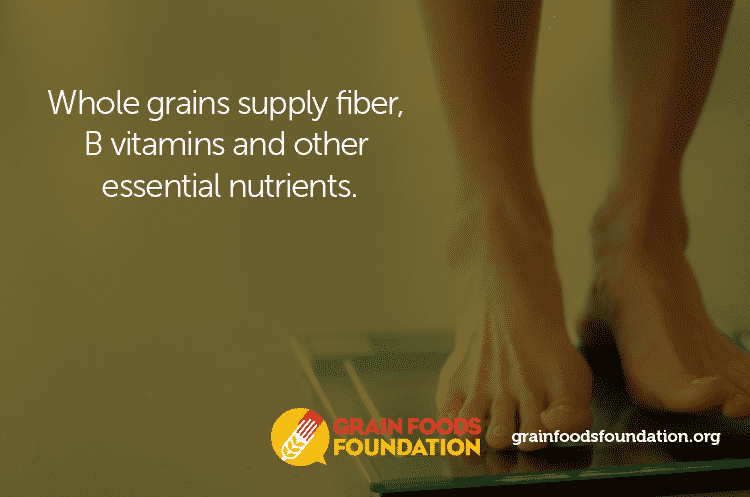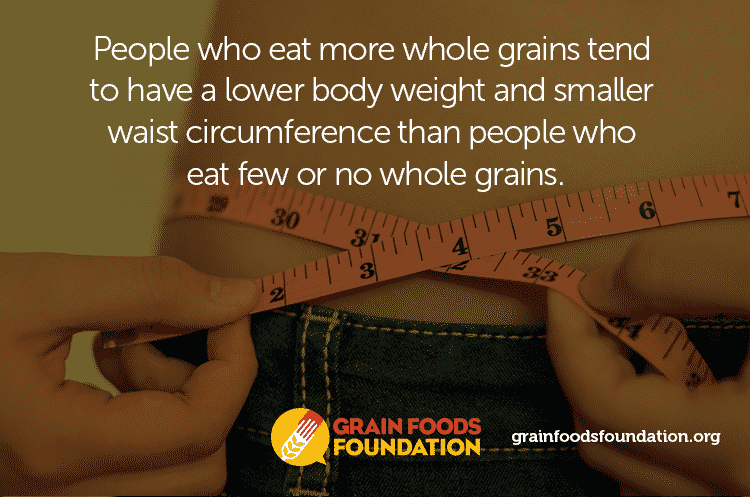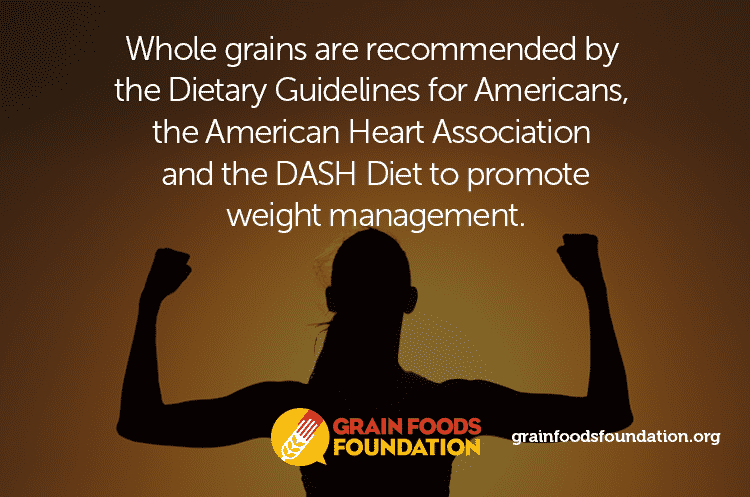Grain foods are a dietary staple, and with good reason: grain foods are an abundant source of carbohydrates, the preferred fuel for the brain, muscles and most organs of the body. But for people seeking to lose or avoid gaining weight, some trendy diet plans recommend avoiding grains, or even all carbohydrates. What gives?
Let’s Talk Science for a Second

The three nutrients providing energy (calories) for the body are protein, carbohydrates and fats. The building blocks for carbohydrates are sugars, much in the same way that the building blocks for protein are amino acids. Cutting out sugars when trying to manage weight makes sense, but the focus should be on added sugars, not sugars found naturally in foods. For example, it makes sense to eliminate soft drinks when trying to lose weight, but not apples. Apples, broccoli, whole grains – these are all carbohydrate-rich foods which get broken down into glucose, the sugar sent through the bloodstream to fuel the body and make it move and function. These foods also supply more than just glucose – they give you fiber, vitamins, minerals and other essential nutrients.
The Skinny on Whole Grains
Whole grains contain all three elements of a grain: the outer bran, which is like the grain’s “skin,”; the germ, or the “heart” of the grain; and the endosperm, the starchy part that makes up about 80 percent of the grain.1 Enriched grains are those which have their bran and germ removed, leaving behind the energy-rich endosperm. While the endosperm contains some vitamins and minerals, the germ and bran are where you’ll find the majority of a grain’s stomach-filling fiber, plus B-vitamins, healthy fats and protein.

Fiber is a nutrient that helps promote satiety, meaning it keeps you feeling fuller longer. Incorporating fiber-rich foods such as fruits, vegetables and whole grains promotes a healthy weight and is part of an overall healthy eating pattern as outlined in the Dietary Guidelines for Americans.2 Whole grains are specifically singled out in MyPlate as supporting weight management,3 and the American Heart Association recommends whole grains due to the fiber and nutrients they provide.4 Furthermore, a meta-analysis found that people with higher whole grain intake tend to have lower body weight and smaller waist circumference compared to lower intake of whole grains.5
Low Fat vs. Low Carbs
The debate over which diet is best: one that is predominately low fat or low in carbs, is an age-old question. Recent research put this debate to the test and found that low-carb and low-fat diets each provide the same weight loss result.6 What was most important was the quality of the diet, which means limiting highly processed foods and increasing intake of fruits and vegetables.
Make Half Your Grains Whole, But the Other Half is Important, Too
Everyone should aim to make at least half of the grains they eat come from whole grain sources. That’s what’s recommended in most healthy eating plans, from the Dietary Guidelines for Americans to the DASH (Dietary Approaches to Stop Hypertension) Diet to the Mediterranean style eating pattern. And while a clinical study in Denmark found that swapping in whole grains (especially rye) over enriched grains led to weight loss,7 other research suggests that enriched grains are also an important component of a healthy diet and contribute to weight management. So don’t ditch enriched!

- According to an analysis of food intake data, adults who ate pasta, cooked cereals and rice were found to have lower body weight and waist circumference compared to adults who reported eating no grain foods in their diets.8
- Similar findings were found among Australians: grain food eaters were associated with having a smaller waist circumference and body-mass index, as well as a higher fiber intake.9
References
- Whole Grains Council: Whole Grains 101. Online at https://wholegrainscouncil.org/whole grains-101/whats-whole-grain-refined-grain.
- U.S. Department of Health and Human Services and U.S. Department of Agriculture. 2015–2020 Dietary Guidelines for Americans. 8th Edition. December 2015. Available at http://health.gov/dietaryguidelines/2015/guidelines/.
- Choose My Plate: Grains. Online at https://www.myplate.gov/eat-healthy/grains/.
- American Heart Association: Whole Grains and Fiber. Online at http://www.heart.org/HEARTORG/HealthyLiving/HealthyEating/HealthyDietGoals/Whole-Grains-and-Fiber_UCM_303249_Article.jsp#.WueEnIjwaUl/.
- Harland JI and Garton LE. Whole-grain intake as a marker of healthy body weight and adiposity. Public Health Nutr. 2008;11(6):554-563.
- Gardner CD, Trepanowski JF, Del Gobbo LC, et al. Effect of Low-Fat vs Low-Carbohydrate Diet on 12-Month Weight Loss in Overweight Adults and the Association With Genotype Pattern or Insulin Secretion – The DIETFITS Randomized Clinical Trial. JAMA. 2018;319(7):667–679.
- Roager HM, Vogt JK, Kristensen M, et al. Whole grain-rich diet reduces body weight and systemic low-grade inflammation without inducing major changes of the gut microbiome: a randomised cross-over trial. Gut. 2017. Published Online First: 01 November 2017: http://gut.bmj.com/content/early/2018/03/08/gutjnl-2017-314786.
- Papanikolaou Y and Fulgoni III VL. Certain Grain Food Patterns Are Associated with Improved 2015 Dietary Guidelines Shortfall Nutrient Intakes, Diet Quality, and Lower Body Weight in US Adults: Results from the National Health and Nutrition Examination Survey, 2005-2010. Food and Nutrition Sciences. 2016;7:772-781.
- Fayet-Moore F, Petocz P, McConnell A, et. al. The Cross-Sectional Association between Consumption of the Recommended Five Food Group “Grain (Cereal)”, Dietary Fibre and Anthropometric Measures among Australian Adults. Nutrients. 2017;9(2):157.

